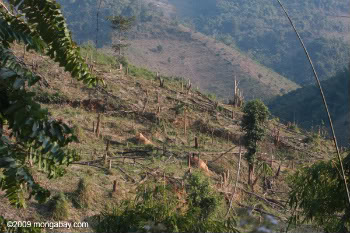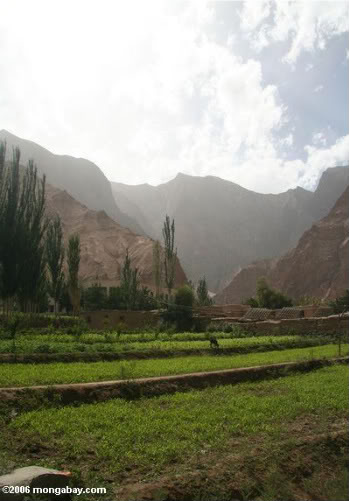|
|
Widespread deforestation led to a 30 percent decline in precipitation in India and 10 percent decline in China.
Between 1700 and 1850 forest cover in India and China plummeted, falling from 40-50 percent of land area to 5-10 percent. Forests were cut for agricultural use across Southeast Asia to feed a growing population, but the changes from forests to crops had unforeseen consequences. A new study published in the Proceedings of the National Academy of Sciences links this deforestation across Southeast Asia with changes in the Asian Monsoon, including significantly decreased rainfall.
The Asian Monsoon—summer rain brought by northeast winds from the Indian Ocean to southern Asia—currently brings precipitation to half of the world’s population. But the mechanisms which create and sustain the monsoon are complex.
“Generally, wind speed is decreased over land compared to that over the ocean, so that moisture transported by the winds is converged over land and brings precipitation,” Kumiko Takata, one of the paper’s authors, explained to mongabay.com. “Such a moisture convergence is important for monsoon precipitation in western Indian subcontinent and southeastern China. We found, in this study, that [moisture convergence was] reduced because of the deforestation due to cultivation.”
 Contemporary deforestation in Southeast Asia, Laos. Photo by: Rhett A. Butler. |
The shift from forest to cropland in Asia decreased vegetation height—crops being shorter than trees—and reduced the amount of leaf cover, which shifted wind patterns, causing a decrease of “reduction in surface wind speed over land,” Takata said, a member of the Research Institute for Global Change, Japan Agency for Marine–Earth Science and Technology.
The loss of leaf cover also leads to increased surface reflectivity—i.e. the percentage of sunlight reflected back by the surface—likely exacerbating the decline in precipitation, by decreasing the amount of evaporation and transpiration from plants to the atmosphere, a cumulated effect known as evapotraspiration.
“We also found that the change in wind speed reached to the lower troposphere. Including all effects, the Tibetan anticyclone in the upper troposphere and the north Pacific anticyclone near the surface, both of which are major features of the Asian summer monsoon, were weakened,” Takata explained.
Using a global climate model, Takata and colleagues were able to recreate the changes in the monsoon during the 18th and 19th Centuries. They found that precipitation decreased by approximately 30 percent in the western Indian subcontinent and by 10 percent in southeast China.
 Agricultural field in China. Photo by: Rhett A. Butler. |
To test these figures the researchers turned to glacier ice cores from the Himalayas. They discovered that their model’s prediction largely matched the data from two glacier cores: a significant decrease in rainfall.
Takata warns, however, that one should be very careful when applying these findings to other regions.
“Similar impacts (reduction in surface roughness and surface reflectivity) would occur in other cultivated regions where there had been forests (e.g., Europe and northern part of North America). However, their effects on climate could be different from those in Asia because of the different climatic conditions.” Takata added that “the impacts of cultivation where there had been grasslands would be smaller than those where there had been forests, because changes in vegetation height and leaf amount are smaller.”
Still, Takata sees relevance in these findings for the contemporary world, where deforestation in similar measure, or more extreme, is still occurring in Southeast Asia and South America.
“Our study showed that land cover/use change induced by human activity so far have had a significant effect on climate change,” Takata said, advising that “we should pay more attention on the impacts of land cover/use change on climate, in addition to other factors, e.g., increases in greenhouse gases and aerosols.”
However, Takata makes it clear that their findings do not view rainfall as inherently connected to forests. When asked whether or not rainfall is an ‘ecosystem service’ of forests, Takata replied in the negative.
“Precipitation is one of the most complicated (high-order) processes, i.e., there are many factors that brings rainfall. In this case, forests… bring much rain, but it is not common,” Takata said.
Citation: Kumiko Takata, Kazuyuki Saito, Tetsuzo Yasunari. Changes in the Asian monsoon climate during
1700–1850 induced by preindustrial cultivation. www.pnas.org/cgi/doi/10.1073/pnas.0807346106.
Related articles
Revolutionary new theory overturns modern meteorology with claim that forests move rain

(04/01/2009) Two Russian scientists, Victor Gorshkov and Anastassia Makarieva of the St. Petersburg Nuclear Physics, have published a revolutionary theory that turns modern meteorology on its head, positing that forests—and their capacity for condensation—are actually the main driver of winds rather than temperature. While this model has widespread implications for numerous sciences, none of them are larger than the importance of conserving forests, which are shown to be crucial to ‘pumping’ precipitation from one place to another. The theory explains, among other mysteries, why deforestation around coastal regions tends to lead to drying in the interior.
Amazonian region likely to become savannah due to burning, deforestation
(03/31/2009) A new analysis shows that the heavily-deforested Amazonian region of Mato Grosso is particularly susceptible to ‘savannization’ due to repeated burning that has likely depleted the region’s soils of precious nutrients. According to the study, published in the Journal of Geophyscial Research, savannization, or the process of tropical ecosystems shifting to savannah, is likely in northern Mato Grosso even if no further deforestation occurs.
75% of world population to face water shortages by 2050
(04/02/2008) By 2025 more than half of countries will face freshwater stress or shortages and by 2050 as much as 75 percent of the world’s population could face freshwater scarcity, but policy measures and new technologies could help reduce the shortfall, report researchers writing in the journal Nature.